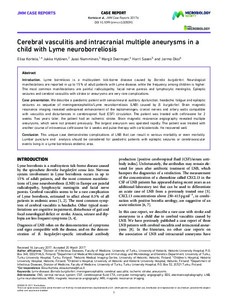Cerebral vasculitis and intracranial multiple aneurysms in a child with Lyme neuroborreliosis
Jarmo Oksi; Harri Saxen; Jukka Hytönen; Margit Overmyer; Elisa Kortela; Jussi Numminen
https://urn.fi/URN:NBN:fi-fe2021042717289
Tiivistelmä
Introduction. Lyme borreliosis is a multisystem tick-borne disease caused by Borrelia burgdorferi. Neurological
manifestations are reported in up to 15 % of adult patients with Lyme disease, while the frequency among children is higher.
The most common manifestations are painful radiculopathy, facial nerve paresis and lymphocytic meningitis. Epileptic
seizures and cerebral vasculitis with stroke or aneurysms are very rare complications.
Case presentation. We describe a paediatric patient with sensorineural auditory dysfunction, headache, fatigue and epileptic
seizures as sequelae of meningoencephalitis/Lyme neuroborreliosis (LNB) caused by B. burgdorferi. Brain magnetic
resonance imaging revealed widespread enhancement of the leptomeninges, cranial nerves and artery walls compatible
with vasculitis and disturbances in cerebrospinal fluid (CSF) circulation. The patient was treated with ceftriaxone for 2
weeks. Two years later, the patient had an ischemic stroke. Brain magnetic resonance angiography revealed multiple
aneurysms, which were not present previously. The largest aneurysm was operated rapidly. The patient was treated with
another course of intravenous ceftriaxone for 4 weeks and pulse therapy with corticosteroids. He recovered well.
Conclusion. This unique case demonstrates complications of LNB that can result in serious morbidity or even mortality.
Lumbar puncture and analysis should be considered for paediatric patients with epileptic seizures or cerebrovascular
events living in a Lyme borreliosis endemic area
Kokoelmat
- Rinnakkaistallenteet [19204]
